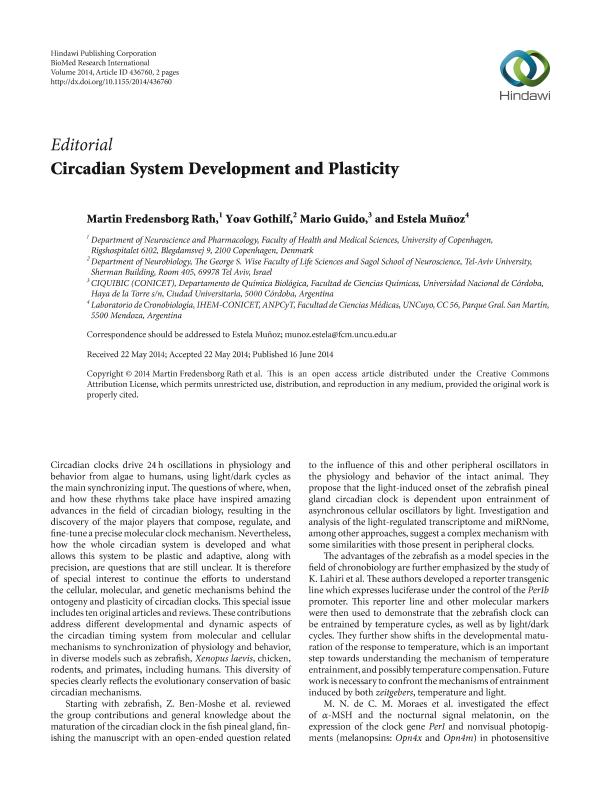Mostrar el registro sencillo del ítem
dc.contributor.author
Fredensborg Rath, Martin
dc.contributor.author
Gothilf, Yoav
dc.contributor.author
Guido, Mario Eduardo

dc.contributor.author
Muñoz, Estela Maris

dc.date.available
2018-01-05T19:58:40Z
dc.date.issued
2014-06
dc.identifier.citation
Muñoz, Estela Maris; Fredensborg Rath, Martin; Gothilf, Yoav; Guido, Mario Eduardo; Circadian System Development and Plasticity; Hindawi Publishing Corporation; BioMed Research International; 2014; 6-2014; 1-2; 436760
dc.identifier.issn
2314-6133
dc.identifier.uri
http://hdl.handle.net/11336/32466
dc.description.abstract
Circadian clocks drive 24 h oscillations in physiology and behavior from algae to humans, using light/dark cycles as the main synchronizing input. The questions of where, when, and how these rhythms take place have inspired amazing advances in the field of circadian biology, resulting in the discovery of the major players that compose, regulate, and fine-tune a precise molecular clock mechanism. Nevertheless, how the whole circadian system is developed and what allows this system to be plastic and adaptive, along with precision, are questions that are still unclear. It is therefore of special interest to continue the efforts to understand the cellular, molecular, and genetic mechanisms behind the ontogeny and plasticity of circadian clocks. This special issue includes ten original articles and reviews. These contributions address different developmental and dynamic aspects of the circadian timing system from molecular and cellular mechanisms to synchronization of physiology and behavior, in diverse models such as zebrafish, Xenopus laevis, chicken, rodents, and primates, including humans. This diversity of species clearly reflects the evolutionary conservation of basic circadian mechanisms.
dc.format
application/pdf
dc.language.iso
eng
dc.publisher
Hindawi Publishing Corporation

dc.rights
info:eu-repo/semantics/openAccess
dc.rights.uri
https://creativecommons.org/licenses/by/2.5/ar/
dc.subject
Circadian System
dc.subject
Development
dc.subject
Plasticity
dc.subject
Rhythmicity
dc.subject.classification
Otras Ciencias Biológicas

dc.subject.classification
Ciencias Biológicas

dc.subject.classification
CIENCIAS NATURALES Y EXACTAS

dc.title
Circadian System Development and Plasticity
dc.type
info:eu-repo/semantics/article
dc.type
info:ar-repo/semantics/artículo
dc.type
info:eu-repo/semantics/publishedVersion
dc.date.updated
2017-12-29T14:10:09Z
dc.journal.volume
2014
dc.journal.pagination
1-2; 436760
dc.journal.pais
Emiratos Árabes Unidos

dc.journal.ciudad
Sharjah
dc.description.fil
Fil: Fredensborg Rath, Martin. Universidad de Copenhagen; Dinamarca
dc.description.fil
Fil: Gothilf, Yoav. Tel-aviv University; Israel
dc.description.fil
Fil: Guido, Mario Eduardo. Consejo Nacional de Investigaciones Científicas y Técnicas. Centro Científico Tecnológico Conicet - Córdoba. Centro de Investigaciones en Química Biológica de Córdoba. Universidad Nacional de Córdoba. Facultad de Ciencias Químicas. Centro de Investigaciones en Química Biológica de Córdoba; Argentina. Universidad Nacional de Córdoba. Facultad de Ciencias Químicas. Departamento de Química Biológica; Argentina
dc.description.fil
Fil: Muñoz, Estela Maris. Consejo Nacional de Investigaciones Científicas y Técnicas. Centro Científico Tecnológico Conicet - Mendoza. Instituto de Histología y Embriología de Mendoza Dr. Mario H. Burgos. Universidad Nacional de Cuyo. Facultad de Cienicas Médicas. Instituto de Histología y Embriología de Mendoza Dr. Mario H. Burgos; Argentina
dc.journal.title
BioMed Research International
dc.relation.alternativeid
info:eu-repo/semantics/altIdentifier/url/https://www.hindawi.com/journals/bmri/2014/436760/
dc.relation.alternativeid
info:eu-repo/semantics/altIdentifier/doi/http://dx.doi.org/10.1155/2014/436760
dc.relation.alternativeid
info:eu-repo/semantics/altIdentifier/url/https://www.ncbi.nlm.nih.gov/pmc/articles/PMC4083865/
Archivos asociados
